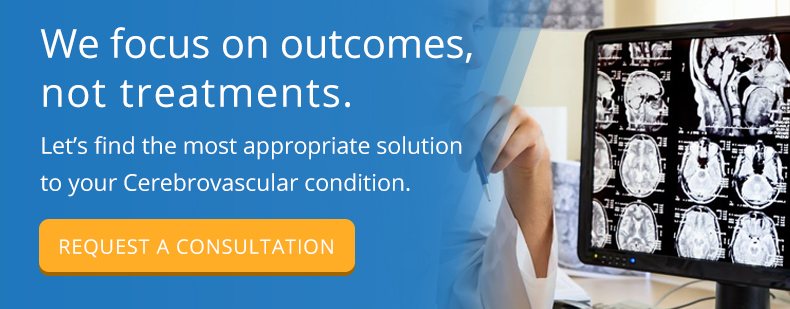Cavernous malformations, also called cavernomas or cavernous hemangiomas, are clusters of abnormal blood vessels that can occur in the brain or the spine. These clusters can alter blood flow, swell or leak, causing a variety of symptoms such as headaches, seizures and problems with coordination and speech. In some cases, medication can manage these symptoms, but cavernous malformation surgery may be needed to eliminate them entirely.
What Is a Cavernous Malformation?
Cavernous malformations occur relatively rarely, but they account for around 15 percent of vascular (blood vessel) abnormalities of the brain and spine. Most are not diagnosed until symptoms such as headaches and seizures appear. These tangled groups of blood vessels are typically thin-walled and distended with blood, so that the cluster resembles a blackberry. Because these vessels are tangled, blood flows more slowly through them, and the fragile cell walls can leak blood into surrounding tissues or burst.
Cavernous malformations in the brain are abnormalities of blood vessels, not brain tissue itself. But swelling and leakage of a cavernoma can create pressure on surrounding brain tissues. Depending on its location, it can trigger seizures, headaches or neurological and cognitive problems such as impaired coordination, numbness and weakness, and difficulties with memory and speech. Malformations can also enlarge and burst, causing a medical emergency. Most of the time, however, they sit silently in the brain.
Who Is at Risk for Cavernous Malformations?
Cavernous malformations are found in one of about every 100 to 200 people. At least 30 percent of people with this condition develop symptoms, usually in their 20s and 30s — the most common age group for diagnosis.
Cavernous malformations are most often found in people younger than 40. About one-third occur in those under the age of 20, and the majority — around 60 percent — are found in people between the ages of 20 and 40. With age, the risk drops — only 10 to 15 percent of diagnoses occur in people over 40.
Cavernous malformations can be either familial or sporadic. When malformations are familial, they appear in multiple family members or in multiple generations of a family. The familial type of cavernous malformations also occurs more often in people of Hispanic descent.
When Is Surgery Needed?
Treatments for cavernous malformations depend on many factors, including a person’s age, overall health and the location and size of the malformation. For some people with small cavernomas or those in high-risk areas of the brain, treatment consists of medication to control symptoms such as seizures and headaches, and regular monitoring to track any changes in the malformation.
But when medication fails to relieve symptoms, or the malformation is located in a readily accessible and low-risk area of the brain, neurosurgeons perform microsurgery to remove the abnormal blood vessels completely. In these situations, cavernous malformation surgery can eliminate symptoms and restore normal functioning.
Preparing for Surgery
Cavernous malformation surgery is performed in a hospital, typically under general anesthesia. Before surgery, you can expect to have an MRI or CT scan to determine the precise location of the malformation, as well as a series of blood tests, x-rays and a general physical examination with a detailed medical history. Once surgery is scheduled, you’ll be given a series of pre-operative instructions, which generally include restrictions on eating and drinking after midnight prior to surgery, and any other recommendations specifically related to your procedure.
Cavernous Malformation Surgery
Microsurgery to remove a cavernous malformation begins with a craniotomy to remove a portion of the skull in order to reach the abnormal blood vessels. During this part of the procedure, your hair is not shaved. It will get parted around the area of the incision. Your neurosurgeon then opens the skin and removes a small segment of bone from your skull. This exposes the dura, the tough gray covering over the brain. Your surgeon then opens the dura and removes the malformation, sealing off the blood vessels surrounding it.
Once the malformation has been removed, the dura is closed, and the piece of skull is replaced. Small metal plates and screws are placed around the bone to keep it stable, and these remain in place permanently to provide support. The incision is closed and dressings are applied.
Recovering in the Hospital
Without complications, cavernous malformation surgery typically requires a hospital stay of three to five days. Right after surgery, you can expect to spend a day or two in the hospital’s intensive care unit while your care team monitors your recovery from anesthesia and checks frequently for signs of bleeding, swelling or neurological problems, such as speech, coordination and memory deficits.
After that, you can expect to be moved to a standard hospital room, where staff continues to check for complications and prepare you to continue your cavernous malformation recovery at home.
Recovering at Home
Overall, recovery from cavernous malformation surgery can take approximately six weeks, depending on factors such as your overall health, age and lifestyle. During this time, activities like driving, lifting heavy objects or exercising strenuously will be restricted. You may want to enlist the help of a family member or friend for running errands and taking care of household tasks.
As you recover, you might experience symptoms like fatigue, headaches and nausea, and your doctors may prescribe medications to reduce pain and swelling and prevent post-operative seizures. As your recovery progresses, you can gradually resume normal activities.
Your doctors will schedule follow-ups to check the healing of your incision, watch for any emerging neurological or cognitive problems, such as weakness in limbs, or difficulties with speech, memory or coordination and will schedule periodic MRI or CT scans. Successful surgery for a cavernous malformation typically resolves the condition and its symptoms completely.
Risks of Cavernous Malformation Surgery
Any surgery can cause complications such as infection, blood clots and reactions from anesthesia and medications. But procedures that cause trauma to the brain’s delicate tissues pose special risks. Your doctors will check your progress closely after surgery to reduce those risks and make appropriate changes to your recovery plan if problems arise.
Stroke
Strokes occur as a result of a blood clot blocking a blood vessel in the brain or by brain bleeding, so this can be a serious risk of cavernous malformation surgery to remove diseased blood vessels. Strokes can cause paralysis, mild to severe neurological problems or even death. Your neurosurgeon will take all necessary precautions to prevent this risk from occurring.
Neurological Deficits
Cavernous malformation surgery requires neurosurgeons to directly access the area of the brain where the malformation is located. Those areas are rich in the neural connections that control a wide range of functions, including memory, movement, spatial orientation and coordination. Depending on the location of the malformation, some neurological deficits can occur as a result of surgery.
These deficits can be transitory so that they gradually resolve over time, but they may also be permanent. If these symptoms persist, or if they are severe, your doctors may recommend a course of physical or occupational therapy to help regain functioning.
Swelling or Bleeding
Trauma to the brain tissue during surgery may cause swelling or bleeding that produces symptoms including headache and neurological deficits. These symptoms can resolve as recovery progresses, or they may require longer-term treatment with physical or occupational therapy.
Treating cavernous malformations depends on factors including your age, overall health, the size and location of the malformation and the nature of your symptoms. Cavernous malformation surgery is a safe microsurgical procedure that can resolve symptoms and restores normal functioning. If surgery is right for you, your neurosurgeons and healthcare team will work with you to create a personalized plan for your treatment and recovery.


